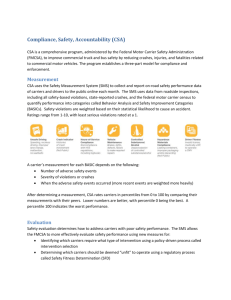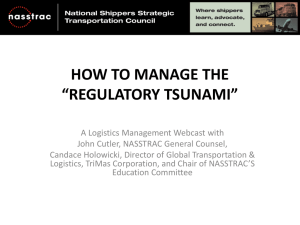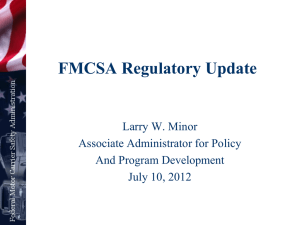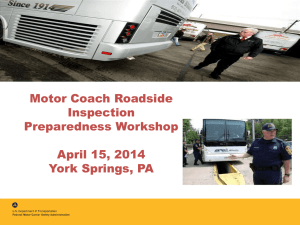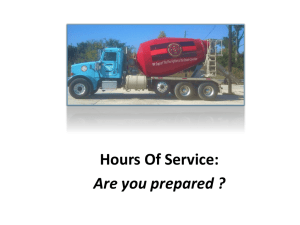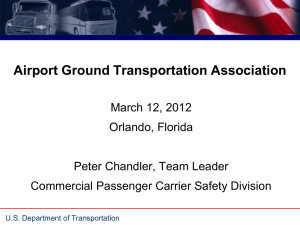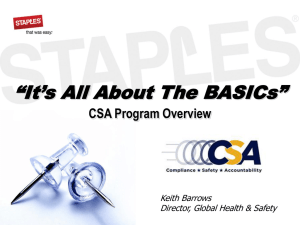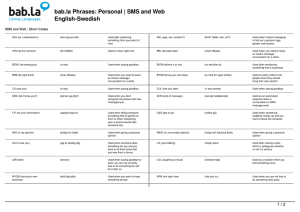CSA
advertisement
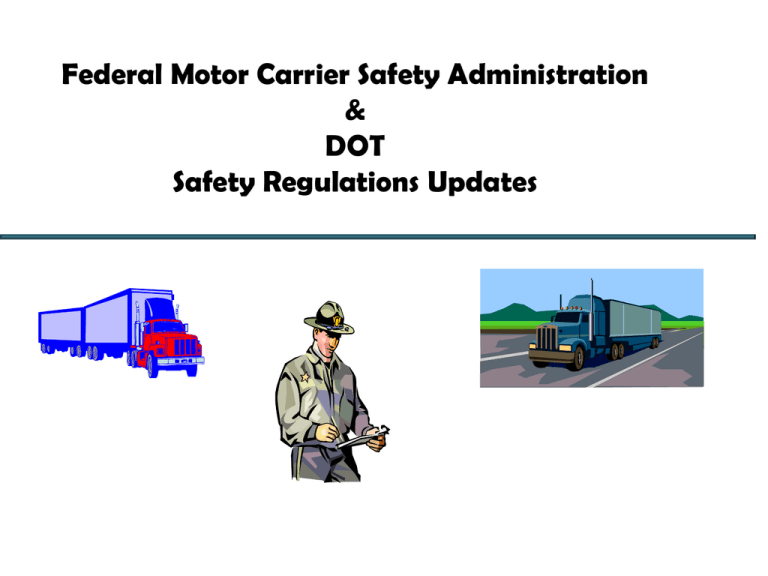
Federal Motor Carrier Safety Administration & DOT Safety Regulations Updates Welcome Tom Hicswa Jr. CDL Director Clark State Community College Phone Number – 937-328-6054 Email – hicswat@clarkstate.edu Topics for discussion: Hours of Service – new regulations EOBRs – Electronic On Board Recording Devices CSA – Compliance Safety Accountability Highway funding bill – Moving Ahead for Progress in the 21st Century Act, or MAP-21 Hours of Service – new regulations: • Current rules for property carrying vehicles: 11 hour drive time 10 consecutive hours off-duty No driving after 14 consecutive hours on duty (can still work) 34 hour restart will reset the 60/70 hour clock to zero Split sleeper berth – 10 hour off duty break can be split into 2 separate rest periods of at least 8 consecutive hours in sleeper berth and second break of at least 2 hours off duty • New rules for property carrying vehicles: •Two significant dates •February 7, 2012 •June 30, 2013 10, 11 and 14 hour rules no change • After February 7, 2012: Time resting in a parked CMV is OFF DUTY. In a moving CMV, up to 2 hours in a passenger seat can be counted as OFF DUTY immediately before or after 8 consecutive hours in a sleeper berth to count as the 10 hour consecutive break off duty. • After June 30, 2013: 34 restart off duty period will reset the 60/70 hour limit if it includes 2 consecutive periods from 1:00 am to 5:00 am. A reset can only be started if 168 hours (7 days) have passed since the start of the last reset period. Other changes which apply to Oilfield operations and property carrying vehicles and can be found at the Federal Motor Carriers website: http://www.fmcsa.dot.gov EOBRs – Electronic On Board Recording Devices: AOBRD vs. EOBR AOBRD or Automatic on-board recording device can be used on commercial motor vehicles manufactured prior to June 4, 2012 . Info can be found in the FMCSA regulations book Part 395.15 EOBR or Electronic on-board recording device must be installed on commercial motor vehicles manufactured after June 4, 2012 EOBRs must be capable of automatic and accurate HOS recording Integrally linked with the CMV computer Have file download capability Will require software and technology updates as rules change Info can be found in the FMCSA regulations book Part 395.16 CSA – Compliance Safety Accountability What is CSA? Compliance and enforcement program (came into law on December of 2010) Focuses on both motor carriers and drivers CSA applies to: Interstate motor carriers operating CMVs with a USDOT number Interstate and intrastate motor carriers hauling hazmat Drivers of CMVs CSA system consists of four major components Data collection Safety measurement (SMS) Safety evaluation Interventions (inspections) The 7 BASICs Seven categories of safety behaviors measured in the SMS (Safety Measurement System) and are Severity Weighted (1 to 10 ) based on crash indicators: Unsafe driving Fatigued driving Driver fitness (not physical health but qualifications) Controlled substances and alcohol Vehicle maintenance Cargo-related Crash indicator Majority of data about drivers and motor carriers is collected at roadside inspections Violations found are entered into the system No violation inspections are also entered into the system Every month SMS Measures roadside violation and crash data performance System updates every 30 days. Calculates a score in the seven BASICs Time weighted Carriers are measured on previous 24 months Drivers are measured on previous 36 months Proposed changes CSA Safety Measurement System: On March 27, 2012, FMCSA launched the preview period for the first set of improvements. The first package of proposed SMS enhancements includes: Strengthening the Vehicle Maintenance Behavior Analysis and Safety Improvement Category (BASIC) by incorporating cargo/ load securement violations from the current Cargo-Related BASIC. Changing the Cargo-Related BASIC to the Hazardous Materials (HM) BASIC to better identify HM-related safety and compliance problems. Better aligning the SMS with Intermodal Equipment Provider regulations. Aligning violations that are included in the SMS with Commercial Vehicle Safety Alliance inspection levels. More accurately identifying carriers involved in transporting HM. Separate crashes with injuries and crashes with fatalities. Modifying the SMS display to change the current terminology, “inconclusive” and “insufficient data,” to fact-based definitions. More information can be found on the FMCSA website Click on the CSA link. MAP-21 Highway funding bill: New Rules: Electronic on-board recording devices (proposed dates – final rule by July 2013 / implementation by July 2015) exact dates are uncertain Entry level CDL training requirements Written proficiency exam for new entrants Safety fitness reviews within 12 months (120 days for busses) National drug/alcohol testing database En-route HazMat inspection procedures Driving record notification system Seatbelts in motor coaches For more information go to: http://www.fhwa.dot.gov/map21/summaryinfo.cfm Questions? Thank You! Tom Hicswa Jr. CDL Director Clark State Community College Phone Number – 937-328-6054 Email – hicswat@clarkstate.edu

